Why to Use Raw Beef When Expirimenting With Bacteria Growth
If learning how to grow bacteria interests you, read on.
How Can Bacteria Help Us?
How Tin Bacteria Harm United states?
What Are Antibacterial Agents?
Experiment #1: Cheek Cell Swab
Experiment #2: Testing Antibacterial Agents
Experiment #3: Soap Survey
Experiment #iv: Bacteria in the Air
Experiment #v: Homemade Yogurt
More Experiment Ideas
Bacteria Overview
Bacteria are 1-celled, or unicellular, microorganisms. They are different from plant and beast cells because they don't have a distinct, membrane-enclosed nucleus containing genetic material. Instead, their DNA floats in a tangle inside the cell.
Individual leaner can simply be seen with a microscope, simply they reproduce then rapidly that they oftentimes form colonies that we can see. Bacteria reproduce when one jail cell splits into two cells through a procedure called binary fission. Fission occurs rapidly in every bit little as 20 minutes. Nether perfect atmospheric condition a single bacterium could abound into over one billion bacteria in only 10 hours! (It'south a good thing natural conditions are rarely perfect, or the world would be buried in leaner!)
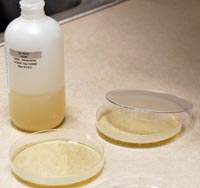
Growing and testing leaner is a fun any-time projection or a great scientific discipline fair projection. Leaner are everywhere, and since they reproduce rapidly they are like shooting fish in a barrel to study with simply a few simple materials. All yous need are some petri dishes, agar, and sterile swabs or an inoculating needle. Agar is a gelatinous medium that provides nutrients and a stable, controlled surroundings for leaner growth. Virtually bacteria will grow well using nutrient agar, simply some more captious bacteria (those with more circuitous nutrient requirements like Bacillus stearothermophilus, Branhamella catarrhalis, and Bacillus coagulans) prefer tryptic soy agar.
You likewise demand a source for bacteria, and this is not hard to find! You can swab your oral cavity or skin, pets, soil, or household surfaces like the kitchen sink or toilet basin. If yous want to study a detail type of bacteria, yous tin can also purchase live cultures. Keep reading to meet iv experiments using bacteria, and many more ideas for science projects (besides consider this hands-on Bacteria Growing Kit)! Adult supervision is recommended when working with bacteria.
How Tin can Bacteria Help Us?
Where would we be without bacteria? Well, we might not be getting bacterial diseases, but we would still be a lot worse off! Bacteria perform all sorts of very important functions, both in our bodies and in the world effectually us. Here are just a few.
Digestion. Our large intestines are full of beneficial bacteria that break down food that our bodies can't assimilate on their own. In one case the bacteria interruption it downward, our intestines are able to absorb it, giving united states of america more nutrients from our food.
Vitamins. Bacteria in our intestines actually produce and secrete vitamins that are important for our health! For example, East. coli bacteria in our intestines are a major source of vitamin K. (Most East. coli is good for us, but at that place is a harmful type that causes food poisoning.)
Food. Bacteria are used to turn milk into yogurt, cheese, and other dairy products.
Oxygen. Cyanobacteria (which used to be called blue-greenish algae) live in water and perform photosynthesis, which results in the production of much of the oxygen nosotros need to breathe.
Cleanup. Oil spills, sewage, industrial waste — bacteria can aid united states of america make clean all of these up! They 'eat' the oil or toxins and catechumen them into less harmful substances.
Bacteria are amazing creatures, aren't they? They can be so dangerous and even so so important at the aforementioned fourth dimension. Keep reading to run across an experiment that uses good bacteria!
How Can Bacteria Impairment United states of america?
Some types of bacteria cause illness and sickness. These kinds of bacteria are chosen pathogens. They reproduce very speedily, similar all bacteria. These come in many forms and can crusade illnesses from an ear infection to strep pharynx to cholera. They can get into our bodies via our mouth and olfactory organ, or through cuts and scrapes. Some are airborne, others are found in food, resulting in food poisoning. Bacteria are also the cause of plaque buildup on our teeth, which tin can atomic number 82 to cavities and gum affliction.
Before the discovery of antibiotics, many severe bacterial diseases had no cure and usually resulted in decease. Antibiotics work by destroying bacteria or inhibiting their reproduction while leaving the torso'southward own cells unharmed. After a time, some bacteria develop resistance to an antibiotic, and it volition no longer exist effective against them. Because of this, scientists are always researching new antibiotics. (Many diseases, such as craven pox, hepatitis, or polio, are caused past viruses rather than bacteria. Antibiotics take no effect confronting these diseases.)
Bacterial infections are common, but many of them can be avoided by skilful cooking, cleaning, and manus-washing practices.
What Are Antibacterial Agents?
How do people terminate leaner from growing and spreading? They control it in two ways: by killing the bacteria cells, and by stopping the leaner from reproducing. An agent is a solution or method which either kills or stops reproduction. Bactericides are agents that kill leaner cells. Static agents inhibit prison cell growth and reproduction.
There are a variety of ways to kill bacteria or proceed it from reproducing.
Physical methods:
- Sterilization. The application of oestrus to kill bacteria. Includes incineration (burning), humid, and cooking.
- Pasteurization. The employ of mild estrus to reduce the number of bacteria in a food.
- Cold temperatures. Refrigeration and freezing are ii of the well-nigh common methods used in homes, for preserving food's life span.
Chemical methods:
- Antiseptics. These agents can be applied directly to living tissues, including human being skin.
- Disinfectants. These agents are not rubber for live tissues. Disinfectants are used to clean toilets, sinks, floors, etc.
- Preservatives. These are used in almost every processed food that is available today. They inhibit bacterial growth in foods.
- Some nutrient preservatives are: sodium benzoate, monosodium glutamate (MSG), sulfur dioxide, salts, carbohydrate, and forest fume.
- Antibiotics. These kill the bacteria cells that are inside the torso, without harming normal cells. Antibiotics often are able to cure once-fatal diseases, such as carmine fever. However, they can impale practiced bacteria along with the bad.
- Amoxycillin and Ampicillin—inhibit steps in cell wall synthesis (edifice)
- Penicillin—inhibits steps in cell wall synthesis
- Erythromycin—inhibits RNA translation for protein synthesis
SAFETY NOTE
While most environmental bacteria are not harmful to healthy individuals, in one case concentrated in colonies, they can be chancy.
To minimize run a risk, wear disposable gloves while handling leaner, and thoroughly wash your hands earlier and after. Never eat or beverage during bacteria studies, nor inhale or ingest growing cultures. Work in a draft-free room and reduce airflow every bit much as possible. Keep petri dishes with cultured mediums closed—preferably taped close—unless sampling or disinfecting. Even then, remove the petri dish only enough to insert your implement or cover medium with bleach or 70% isopropyl booze.
When finished experimenting, seal dishes in a plastic bag and dispose. Cover accidental breaks or spills with bleach or alcohol for ten minutes, then carefully sweep up, seal in a plastic bag, and discard.
Preparing Civilisation Dishes
Before you tin can grow bacteria, yous'll need to prepare sterile culture dishes. A 125ml canteen of nutrient agar contains enough to fill about 10 petri dishes.
Water Bathroom Method – Loosen the agar bottle cap, but practice non remove it completely. Place the canteen in hot h2o at 170-190 °F until all of the agar is liquid. To prevent the bottle from tipping, keep the water level even with the agar level.
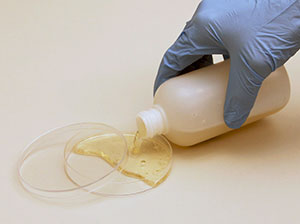
- Let the agar cool to 110-120 °F (when the canteen yet feels warm merely non too hot to touch) earlier pouring into petri dishes.
- Slide open the cover of the petri dish merely plenty to pour agar into the dish. Cascade enough agar to cover 1/ii to 2/3 of the bottom of the dish (about 10-13ml). Don't permit the bottle oral fissure touch the dish. Cover the dish immediately to prevent contagion and tilt it dorsum and along gently until the agar coats the entire bottom of the dish. (Make full as many dishes as you have agar for: you tin can store extras upside down until you're ready to use them.)
- Let the petri dishes stand one hour for the agar to solidify earlier using them.
Experiment #1: Cheek Cell Swab
Make a civilisation dish using the instructions above. Once the culture dish is prepared, utilise a sterile cotton wool swab or inoculating needle and swab the within of your cheek. Very gently rub the swab over the agar in a few zigzag strokes and replace the lid on the dish. You lot'll demand to permit the dish sit down in a warm area for three-7 days earlier bacteria growth appears. Tape the growth each solar day with a drawing and a written description. The individual bacteria are besides tiny to meet without a high-power microscope, but you lot tin can see bacteria colonies. Distinguish between dissimilar types of bacteria past the color and shape of the colonies.
Experiment #2: Testing Antibacterial Agents
Preparing Sensitivity Squares
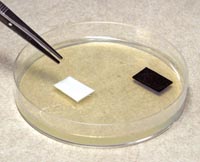
One method for testing the antibacterial effectiveness of a substance is to use 'sensitivity squares.' Cut small-scale squares of blotter paper (or other absorbent paper) and and so soak them in whatever substance y'all want to examination: iodine, ethyl booze, antibacterial soap, antiseptics, garlic, etc. Use clean tweezers to handle the squares and so you don't contaminate them. Label them with permanent ink, soak them in the chosen substance, and blot the backlog liquid with a paper towel.
Collecting Leaner
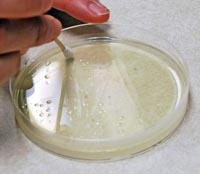
Decide on a source for collecting leaner. For using sensitivity squares, make sure there is but one source, and keep each dish every bit consistent equally possible. Sources could include a kitchen sink, bathroom counter, cell phone, or another surface yous would similar to test. Rub a sterile swab beyond the chosen surface, and so lightly rub it across the prepared agar dish in a zigzag blueprint. Rotate the dish and repeat.
Setting Up an Experiment
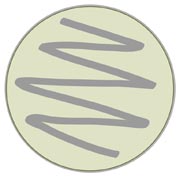
Each experiment should have a control dish that shows bacteria growth under normal weather and one or more test dishes in which y'all change certain variables and examine the results. Examples of variables to test are temperature or the presence of antiseptics. How exercise these impact bacteria growth?
- Label one dish 'Control.' Then in your test dish, use tweezers to add together the sensitivity squares that have been soaked in a substance you wish to test for antibacterial properties. It's a good thought to add a plain square of blotter newspaper to see if the newspaper by itself has any issue on bacteria growth. For best results, use multiple exam dishes and control the variables so the conditions are identical for each dish: bacteria nerveless from the aforementioned place, exposed to the aforementioned corporeality of antibacterial substance, stored at the same temperature, etc. The more tests you perform, the more data you volition collect, and the more confident you can exist virtually your conclusions.
- Place all the dishes in a dark, room-temperature place like a closet.
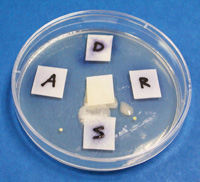
Expect iii-seven days and examine the leaner growth in the dishes, without removing the lids. Y'all will run across multiple circular dots of growth; these are leaner colonies. Depending on where you collected your bacteria samples, y'all may have several types of bacteria (and even some mold!) growing in your dishes. Unlike types of colonies will have unlike colors and textures. If yous take a compound or stereo microscope, effort looking at the colonies up close to meet more of the differences.
Compare the amount of leaner in the control dish to the amount in the test dishes. Side by side, compare the amount of bacteria growth around each paper square. Which one has bacteria growing closest to it? Which one has the least corporeality of leaner growing near it? If you did more than one examination dish, are the results similar in all the test dishes? If not, what variables do you think might take caused the results to exist unlike? How does this affect your conclusions?
For a variation on this experiment, test the effect of temperature on bacterial growth instead of using sensitivity squares. Put a command dish at room temperature, and place other dishes in dark areas with different temperatures.
Experiment #3: Soap Survey
Every fourth dimension you touch something you are probably picking upward new leaner and leaving some behind. This is how many infectious diseases spread — we share our bacteria with everyone around usa! Even bacteria that lives safely on our peel can make us ill if information technology gets inside our bodies through our mouths or cuts and scrapes. This is one reason why it is so important that nosotros wash our hands oft and well.
What kind of soap works best for cutting down on the bacteria on our easily? You can examination this past growing some bacteria cultures using agar and petri dishes.
Materials
- Two (or more) petri dishes
- Sterile swabs
- Agar
- Blotter paper or other absorbent paper
- Forceps or tweezers
- Different kinds of hand cleaners: regular soap, antibacterial soap, dish soap, mitt sanitizer
What To Exercise
1. Ready the agar according to the directions on the label, then cascade enough to cover the bottom of each petri dish. Embrace the dishes and let them represent about an hr until the agar has solidified again. (If you aren't going to use them right abroad after they have cooled, store them upside downwardly in the fridge.)
two. When your petri dishes are fix, collect some leaner from your mitt or the hand of a volunteer. (Make sure the person hasn't washed his or her hands too recently!) Practice this by rubbing the sterile swab over the palm in a zigzag pattern.
iii. Remove the cover from the petri dish and lightly rub the swab back and forth in a zigzag blueprint on the agar. Turn the dish a quarter plough and zigzag again. Cover the dish and repeat steps two and iii for the other dish, using a new sterile swab. Label the dishes "Exam" and "Control." (You may desire to do more than 1 test dish, so you can compare the results.)
iv. Cutting the blotter paper into small "sensitivity squares." Apply permanent ink to label the squares for the different types of hand cleaners you are going to examination, east.g., "R" for regular soap, "A" for antibacterial soap, and "S" for hand sanitizer. Using tweezers, dip each square into the appropriate cleaner. Blot the excess cleaner on a paper towel and and so place the squares on the agar in the "Test" dish. (Spread the squares out and so there is distance betwixt them.) Add i square of patently blotter paper to test if blotter paper past itself has any effect. Don't put any squares in the "Command" dish – this i will show you what the bacterial growth will look like without whatever soap.
5. Put the dishes in a dark, room-temperature place like a cupboard and leave them undisturbed for a few days.
What Happened
The rate of bacteria growth in your dishes will depend on temperature and other factors. Check your cultures afterward a couple of days, just you'll probably want to look 5-vii days before recording your data. Y'all will see multiple circular dots of growth; these are bacteria colonies. In that location may be several types of leaner growing in the dishes. Different types of colonies will have different colors and textures.
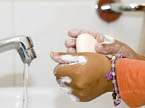
For each soap test, count and record the number of leaner colonies in each dish. To encounter how effective each soap was, dissever the number of colonies in the test dish by the number of colonies in the control dish, then subtract the event from 1 and write the answer as a percentage. For example, if your control dish had 100 colonies and your soap test dish had xxx, the soap eliminated 70% of the leaner: one — (30 ÷ 100) = .7 = 70%
According to your results, which type of soap was the nigh effective at eliminating bacteria? Does "antibacterial" soap actually work improve than regular soap? How well did washing hands in water without soap work? What farther tests could you lot practise to decide which soaps and mitt washing methods are most effective at eliminating bacteria?
Experiment #four: Bacteria in the Air
You lot demand ii culture dishes for this experiment, in which you'll demonstrate how antibacterial agents (such equally antibiotics and household cleaners) affect bacteria growth.
Leave the dishes with their lids off in a room-temperature location. Go out the culture dishes exposed for nearly an hour.
While you lot wait, cut modest squares of paper (blotter paper works well), characterization them with the names of the antibacterials you're going to test (e.chiliad. 'Fifty' for Lysol, 'A' for alcohol, etc.), and soak each in a different household chemical that you lot wish to test for antibacterial backdrop. If you accept fourth dimension, you might also experiment with natural antibacterial agents, such as tea tree oil or reddish pepper. Wipe off any excess liquid and employ tweezers to gear up each of the squares on a different spot in one of the culture dishes. The second culture dish is your 'control.' It will show you lot what an air bacteria culture looks like without any chemical agents.
Store the dishes (with lids on) in a dark identify similar a cupboard where they will be undisturbed for a few days. After three-7 days, take both culture dishes and advisedly observe the leaner growth in each dish, leaving the lids on. The bacteria will be visible in small, colored clusters. Take notes of your observations and brand drawings. You could also answer the post-obit questions. In the command culture, How much of the dish is covered with bacteria? In the sensitivity square test culture, Have the bacteria covered this dish to the same extent every bit the control culture? What effect have each of the chemicals had on the bacteria growth? Did a item chemical kill the bacteria or just inhibit its growth?
- For farther study you could use an antibiotic disc fix to see what unlike antibiotics can do confronting bacteria.
- For a more advanced project, learn how gram staining relates to the use of antibiotics.
Experiment #5: Homemade Yogurt
Generally when people think of 'bacteria,' they think of harmful germs. Still, not all forms of leaner are bad!
You can bask a tasty product of good bacteria by making a batch of yogurt at home.
You'll need to use a starter (available at grocery or wellness food stores), or else one cup of plain, unflavored yogurt that has alive cultures in it. (If it contains live cultures, it will say so on the container.)
Slowly heat four cups of milk until it is hot, but not boiling or scalding. The temperature should be around 95-120 degrees to kill some of the harmful bacteria. Cool slightly, until milk is warm, and then add together 1 loving cup of active yogurt or the starter.
Put the mixture in a large bowl (or glass jars) and cover. Make sure that the bowl or jars are sterilized before using by either running them through the dishwasher or washing them with very hot water.
In that location are ii dissimilar methods for culturing the yogurt mixture: You can put the covered bowl or jars into a clean plastic cooler, and fill the cooler with hot h2o to just beneath the meridian of the culture containers. With this method, y'all volition need to occasionally refill the cooler with hot water, and so that the temperature of the yogurt stays consistent. The other method is to wrap the containers in a heating pad and towels, setting the heating pad on low to medium heat.
Check the mixture after heating for 3 1/2 to four hours. It should be 'fix,' having a smooth, creamy consistency like to store-bought yogurt. If the mixture is not set upward nonetheless, heat it for some other 1-two hours. When information technology is the right consistency, add some flavoring—such every bit vanilla excerpt, chocolate syrup, or berries—and store the yogurt in the fridge. It should go on for a couple of weeks. For safety, we propose that y'all practice non eat any yogurt that has separated or has a non-typical consistency.
More than Leaner Experiment Ideas
Here are some other project ideas for you to try on your ain or apply as a basis for a leaner science fair project:
- Mouthwash. Swab your teeth and gums and run across how well toothpaste or mouthwash piece of work against the plaque-causing bacteria on your teeth.
- Dog's oral cavity: Take you heard people say that dogs' mouths are cleaner than humans'? Design an experiment to test whether this is really truthful!
- Band-aid. Some band-aids are advertised as beingness antibacterial. Test to run across if they really work better than regular band-aids at inhibiting bacteria.
- Water canteen. Is it safe to keep refilling a h2o bottle without washing it? Test a sample of h2o from the bottom of a h2o canteen that has been used for a couple days and compare information technology to a sample from a freshly-opened, clean water canteen. You can likewise examination to see if a bottle gets more bacteria in it if you drink with your rima oris or with a straw.
- Shoes. Practise bacteria abound in your shoes? Is there a difference in bacteria growth between textile shoes and leather? Practise human foot powders work to cutting downwardly on bacteria?
- Toothbrush. Do bacteria grow on your toothbrush? What are some ways you could try to continue it make clean? Mouthwash? Hot h2o?
- Makeup. Some people recommend getting new mascara every six weeks because leaner tin can grow in the tube. Test this by comparison bacteria growth from erstwhile mascara and new, unused mascara. You can also test how much leaner is on other kinds of makeup.
Source: https://learning-center.homesciencetools.com/article/bacteria-experiment-guide/